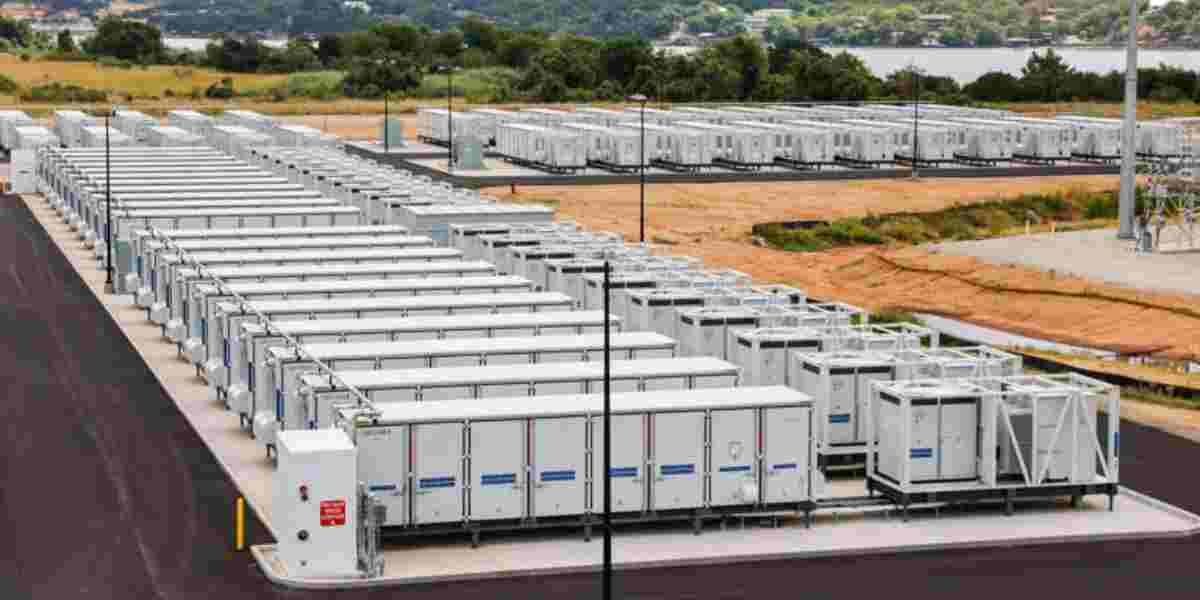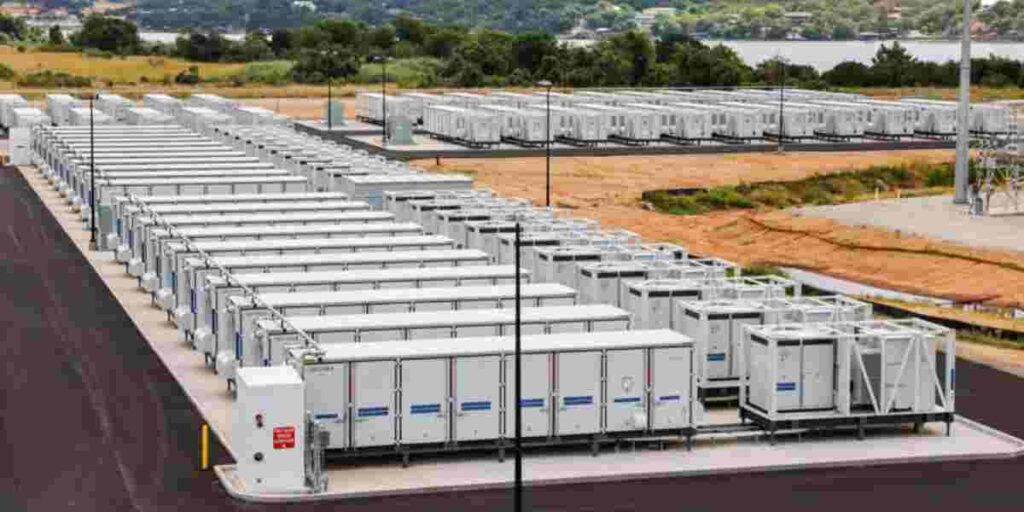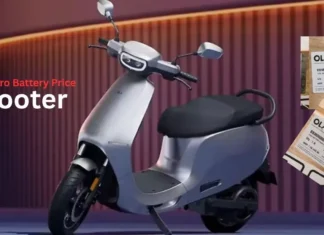
GRANBURY, Texas – This is what modern reliability looks like on the Texas grid.

A 240-acre industrial site, along a bend of the Brazos River an hour’s drive southwest of Fort Worth, brings together old-school fossil fuels and the latest in renewables. A natural gas power plant and a storage battery system work side by side, usually to meet the ever-rising demand for electricity in Texas. There’s also a week’s worth of backup diesel fuel on site, just in case.
The DeCordova facility, owned by Vistra Corp., based in Irving, the state’s largest energy supplier, has been generating electricity since 1975. The original gas-fired steam plant was replaced with four combustion turbines in 1990. Four years ago they received a major upgrade, allowing Vistra to fire up gas units and generate full loads in 10 minutes.
Do you need a quicker response? The storage batteries next door can instantly ignite and feed approximately 26,000 megawatts into the grid, providing enough power to cool 52,000 homes during peak conditions. Vistra spent just over $125 million on the batteries, which came online in May. The system includes 22,360 battery modules housed in 86 air-conditioned shipping containers that seem to stretch on and on.
It’s the largest energy storage system in the state, the company said, and the first to be paired with a natural gas “peaker” plant that’s designed to come on during periods of high demand. “We decided to make the investment in reliability and resiliency,” said Claudia Morrow, Vistra’s senior vice president of development.
Reliability has become the catchword for Texas’ electric industry since February 2021. That’s when a brutal winter storm shut down much of the grid for days, cutting off power to millions and leading to hundreds of deaths. Since the catastrophic event, state leaders have put reliability first, ahead of simply creating more cheap power.
They overhauled the regulatory agencies, including the Public Utility Commission and the grid operator it oversees, the Electric Reliability Council of Texas, known as ERCOT. Regulators have taken many steps to ensure the lights stay on, from requiring more reserves on the grid to ordering gas and coal plants to delay maintenance so they can remain online. So far, the approach is working, despite many days of record demand driven by high temperatures and strong population growth.
But most agree that Texas needs a long-term solution, a more lasting way to strengthen the network. And batteries are a key part of the equation, Morrow said, both to meet peaks in demand and to propel the state into the transition to cleaner energy. Over the past five years, Texas has attracted many new generations, mainly in wind and solar energy.
This is good for the environment and consumers’ pockets, but it is risky for the network. If the wind doesn’t blow or the clouds cover a large part of the state, resource performance doesn’t even come close to capacity. When this happens in difficult conditions, additional energy needs to be quickly delivered to avoid the possibility of DC power outages.
Plants like Vistra Gas Peak are some of the first options. At precisely noon on a recent Friday, three gas units were activated simultaneously, as they did for much of the hot summer. Later, usually around 4pm. at 17m, the batteries are activated instantly, often when demand approaches the daily maximum and the time to charge the battery is essential.
How often are DeCordova batteries used? “With this summer, it’s been every day,” Morrow said. The battery system also impressed veteran workers, said plant supervisor Tyler Wensel. “It responds to network changes immediately,” he said. “We are blown away by this.” Last year, battery storage capacity nationwide more than tripled, according to the US Energy Information Administration. ERCOT’s storage capacity has similarly increased and is on track to increase again in 2022 and 2023. . For the next year, the batteries are expected to add 8,372 megawatts to the ERCOT grid, enough power for 1.7 million Texas homes during peak conditions.
The biggest downside is that they usually only last an hour. Vistra typically charges batteries at night when wind power is plentiful and cheap, and sells battery power when demand is high, as do prices. In the competitive Texas electricity market, generators are paid only for the energy sold to the grid, and the generators decide whether the current rate is sufficient to start the machines. Vistra’s natural gas units can run as long as there is fuel, assuming it makes economic sense to run them for a limited time.
A quick-starting gas plant and batteries that can deliver instantly are a good combination to help fortify the grid, said Joshua Rhodes, a researcher and energy expert at the University of Texas at Austin. “That’s one way of adding firm capacity to the system, and it makes for a nice reliability product,” Rhodes said.
It’s especially valuable in late afternoons when wind is low: “We do need something — something firm — to be able to step in and turn on during those times,” Rhodes said. Vistra owns about 18% of capacity on ERCOT, more than any generator. At times, such as during the 2021 winter storm, Vistra provided an even larger share of power to Texas.
The company has approximately 60 active and retired generation sites in 12 states, including here. And it’s reusing resources and putting renewable energy in place as part of a broader push towards clean energy. In September 2020, Vistra unveiled an ambitious plan to reduce its carbon footprint, driven by a commitment to build seven zero-carbon projects in Texas.
Vistra said it will spend $ 850 million to add nearly 1,000 megawatts of clean energy to the ERCOT grid. Three projects in Texas were launched this summer: solar plants in Live Oak and Crane counties and the De Cordova battery system. Jim Burke, a longtime Vistra executive who became CEO this month, said the company is excited about what’s to come and the growth potential of clean energy.
Vistra aims to more than double its zero-carbon production by 2026, including many storage batteries, which are receiving a boost from tax credits in a climate bill recently passed by Congress. “But we will also continue to be disciplined on projects,” Burke said in an Aug.5 earnings call. He discussed the challenges of bringing more dispatchable generation to the Texas market, especially natural gas plants. Regulators are redesigning ERCOT’s market pattern and said they need to figure out how to incentivize new construction while maintaining existing fossil fuel plants.
It hasn’t happened yet, he said, but Vistra may consider adding a natural gas plant at some point. “Potentially, with market reform, it could work,” Burke told analysts. Whatever the details, Burke was clear on the end goal: “We think there should be a focus on reliability,” he said. It’s more complicated than it looks. “There is nothing specific in the market that says, ‘You will provide reliability at this price,'” said Michelle Michot Foss, a researcher at Rice University’s Baker Institute for Public Policy. While Texas needs more natural gas plants, it would like to see generators use their resources to win over demanding customers.
Market forces, he said, are more effective than mandates. The Vistra plant in DeCordova has abundant controllable and dispatchable generation: a quick-start gas plant with reserve fuel plus a battery system to provide additional power. Put them all together and sell the package, Foss said, “It’s the most reliable thing you can offer a customer.”
Read Also: 5 Rules You Should Follow To Make Your Electric Vehicle Battery Last Longer



